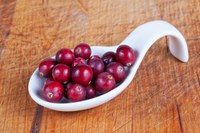Prairie Fare: Inspire your menus with ruby red cranberries
(Click an image below to view a high-resolution image that can be downloaded)
I bought a garland of fake popcorn and cranberries a couple years ago. It reminded me of a party I attended as a kid, when we strung popcorn and cranberries on string to make holiday décor. We wrapped the garland around a staircase.
We also pulled taffy that day. I probably still have scars from the hot mixture, but it was fun.
Cranberries are widely used in menus at the end of the year, especially as a side dish for turkey dinners. Cranberries are primarily harvested in the fall.
Besides fresh berries, we can buy cranberries in various forms all year. They include dried sweetened berries, cranberry jellies and juice.
Cranberries grow on low bushes or vines primarily in Massachusetts, Wisconsin, New Jersey, Oregon and Washington state. Canada and Chile also produce these tart berries.
Cranberries are in the same plant family as their sweeter cousins, the blueberries, and share genetics with rhododendrons, a flowering plant.
Cranberries, like many other fruits, are a good source of vitamin C. Vitamin C is an antioxidant nutrient, meaning that it helps protect cells throughout our body from damage. Antioxidants may play a role in the functioning of our immune system and may reduce risk for several diseases, including cancer and heart disease.
Cranberries get their rosy red color from pigments (natural colorants) called “anthocyanins.” These pigments are believed to be responsible for many health benefits. In acidic fruits, like cranberries, they are red. Anthocyanins are blue in blueberries.
Beneficial phytochemicals (natural plant chemicals) are part of the reason we in nutrition advise consuming more fruits and vegetables of all types. Fruits also add texture, color and flavor to food.
Indigenous tribes in North America recognized the benefits of cranberries as a valuable food source centuries ago. Many indigenous tribes made pemmican, which helped sustain them nutritionally throughout the year.
Pemmican was made by combining dried meat from bison, deer or elk, dried fish such as salmon, or other protein sources with cranberries and tallow (a fat source). Pemmican was an energy-dense portable food. Some tribes used cornmeal instead of meat.
Pemmican could be eaten “as is” or used as the base for meals when it was combined with other foods and cooked to make soups or stews. Some current commercial products inspired by pemmican are made in the form of bars and sticks in South Dakota.
Earlier populations recognized the medicinal properties of cranberries. Indigenous populations used cranberries to help treat kidney and bladder disease. Settlers from England used cranberries as a remedy for scurvy (vitamin C deficiency disease) and other ailments.
Perhaps the most notable and well-studied potential health benefit is the link of cranberries to reducing the risk for urinary tract infections (UTIs). While cranberries do not necessarily “treat” an existing UTI, the anthocyanins have antibacterial properties to protect you from UTIs. The natural components in cranberries prevent bacteria from adhering to our urinary tract.
In other words, having a glass of cranberry juice may help normalize the natural bacteria in our bodies, while providing hydration and other nutrients.
Cranberries are quite tart compared to many other berries. Try some dried sweetened cranberries on salads, or add dried cranberries to a trail mix or granola bar recipe. Cranberries can be used to make relish, cakes, cookies, breads, sauces, pie, salad, cocktails and many other recipes.
Have you ever made chutney? Chutney is a cross between relish and jelly. Cranberries add color, tartness and flavor. Try spooning cranberry chutney over cream cheese and serve with crackers, or serve as a condiment with roasted poultry, ham or beef.
This recipe for home-canned chutney was developed at the National Center for Home Food Preservation. Follow the directions closely for a safe home-canned product. Learn about home canning, including how water-bath can, at www.ag.ndsu.edu/food. Navigate to “Food Preservation” to learn more.
Cranberry Orange Chutney (for Canning)
24 ounces fresh whole cranberries
2 cups chopped white onion
2 cups golden raisins
1½ cups white sugar
1½ cups packed brown sugar
2 cups white distilled vinegar (5%)
1 cup orange juice
4 teaspoons peeled, grated fresh ginger
3 sticks cinnamon
Wash and rinse half-pint canning jars, and keep hot until ready to use. Prepare lids according to the manufacturer’s directions. Rinse cranberries well. Combine all ingredients in a large Dutch oven on a stovetop. Bring to a boil over high heat; reduce heat and simmer gently for 15 minutes or until cranberries are tender. Stir often to prevent scorching. Remove cinnamon sticks and discard. Fill the hot chutney into clean, hot half-pint jars, leaving ½-inch headspace. Remove air bubbles and adjust headspace if needed. Wipe rim of jars with a dampened clean paper towel and apply two-piece metal canning lids. Process in a boiling water canner according to your altitude. Process 10 minutes at altitudes of 0 to 1,000 feet, 15 minutes at altitudes of 1,001 to 6,000 feet, or 20 minutes at altitudes above 6,000 feet.
Note: You can add additional spices (cloves, dry mustard, cayenne pepper) to taste during the simmering time. Makes eight half-pint jars.
Note from Julie: If you are feeling crafty, you could add a fabric circle to the top of the sealed jar, top with the screw band and tie with a ribbon for a homemade gift.
(Julie Garden-Robinson, Ph.D., R.D., L.R.D., is a North Dakota State University Extension food and nutrition specialist and professor in the Department of Health, Nutrition and Exercise Sciences.)
NDSU Agriculture Communication – Dec. 7, 2023
Source: Julie Garden-Robinson, 701-231-7187, julie.garden-robinson@ndsu.edu
Editor: Elizabeth Cronin, 701-231-7881, elizabeth.cronin@ndsu.edu




